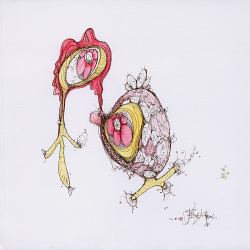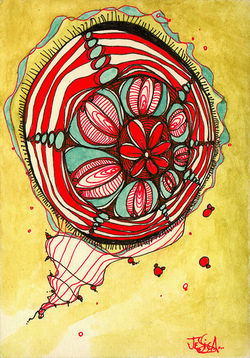Alexander Calder’s Circus… A little inspiration.
Drawing on Nature
I’m a big fan of sketchbooks and what goes into them the blog to follow has a great selection of scans and text about the sketchbooks she uses. Great little drawings and great color. She uses my favorite mediums- ink and watercolor combination. Awesome stuff.


As always all art is property of the artist.
Happy New Year!
I hope that everyone out there had a fantastic 2007 and
that, thus far, your 2008 is off to a great start. Best wishes to everyone out
there for a great year!
Chapbook from 1999
I made this book in collaboration with a friend of mine. It is pretty much the only book I’ve made in collaboration with anyone. It’s a pretty simple Japanese stab style binding. Done with black cotton crocheting thread. The stations were bored with a dremel. The fore edge of each page is the folded edge of the sheet of paper. at the time of printing I had a ancient bubble jet. I was working some place where once a week I had unfettered access to the photocopy machine… I made zines then too. I printed the text, took it to work, copied the pages onto my really nice paper took them home and printed by hand all the little block prints then collated and folded every book, clamped and drilled holes then stitched it all up. The whole process took a long long time. My friend and I were mailing back and forth a notebook with the images and text, until we had everything agreed upon, then I typed it all up and emailed it to my friend, she tweaked the text, then I made it fit onto the page.
I’ve got to say that this was a great project, I love how the final product came out. I think we made a total of 100 books. The cost was a lot though. I was really poor at the time of us making this as was my friend, I want to say that we spent about $50 getting this thing going and never made any money on it. I still have a stack of the books. I sold a few on eBay and my friend had the other half of them and I’ve still got a stack of them.
I still thing that they are really cool.
New CamCorder
After shooting several lame videos with the webcam,
researching it’s capabilities on the net as well as optimization AND
downloading the most recent drivers and software I was unable to get it to
operate at it’s advertised recording rate of 30fps. The best I ever got was 8.
AS a result I loaded up and made several crappy videos. The quality that I like
isn’t in those videos. I’m leaving them up on YouTube as a reminder of the learning
curve and because people have commented on them and I might as well. Out of
frustration and anger I took the webcam back, got the cash put onto a gift card
and went shopping for a camcorder that would A) record video B) offer easy
linking to my laptop and C) Grow with me as I upgrade my computer and other
equipment in the future. I had settled on a sweet little canon, but they were
out of stock.
So I spent a little more than the budget allowed and bought
a HDD JVC Everio. It’s super easy to use, has manual adjustments, and hooks up
to my laptop with ease making downloading my videos super easy. It came with
some editing software that’s pretty easy to use and so you can expect some new,
higher quality videos of my books and journals soon.
I have made the decision to reshoot all my old videos as
well. So all those barely clear videos I made in the past will be redone in new
sharp video. I also have the option of saving them in DVD quality and burning
them to DVD, which could be very cool.
So all you can expect over the next few weeks that I’ll be
loading up a few new videos. AS usual if you feel like linking to those videos
or loading them up to your blog feel free to do so!
A quick reminder: My etsy shop will be having a $2 shipping
sale for the rest of 2007 and the month of January 2008. Shipping on items
$9.99 and up will be only $2. Multiple items will ship for only $2.
Unfortunately this applies only to shipping in the US only. International
buyers will have to contact me to get international shipping prices. Feel free
to post this info to your blog.
YouTube Journal
I found this on YouTube the other day the YouTuber Cordebra says this:
This is my illustrated diary with entries from 2004 and a few pages of 2005. The book is like a moleskine.
I say it looks like an honest life book or journal of some one’s life. Great little nugget.
MY first Hedgehog ever
This is the first hedgehog I ever made. It’s a 3.5×5.5 inch 100 page hardcovered book, with a long stitch binding. The elastic on it is completely gone- a strip of braiding with hard little lumps. The leather along the spine is from a recycled totally sweet 1970’s jacket I snagged at goodwill in Bangor Maine. IT had holes and it made great red brown books. Anyway Check it out
$2 Shipping Sale
For all my etsy buyers in the US I’m having a $2 shipping sale. Shipping on all items $9.99 and up is just $2, even when you buy multiple items. This applies only to buyers in the US, I can’t afford to ship worldwide for this price. International buyers will have to convo me for shipping.
Head on over to etsy, check out my books and buy with super low shipping.
Jessica Doyle
Check out the little ACEOs and sketches from Jessica Doyle. Her blog is full of fantastic art and imagery as well as some great raw emotional posts. Anyone who has worked retail can feel her pain.


All art this post is property of the artist.
Work(art) Capacity Week 4
I was reading an article about work capacity. It’s a physics
concept that I haven’t thought much about since I was in high school but it’s
one of those great concepts that really can apply to so much more than just
physics. The article that I was reading was about working out and being able to
more than the next person when you need to but I was thinking how can I apply
that concept to art, because really it doesn’t matter too much to me if I can’t
relate it to art.
So I got to thinking what can I do to increase my work
(art) capacity. I came up with 4 items to do so. For the next 4 weeks I’m going
to post a new work(art) capacity item.
#4 Use your tools. We all have a variety of
tools available to us, many save time. I saved a lot of time taking my finished
book blocks to staples and having them trim them for me. I spent $4 but saved
an hour. In my mind $4 is worth it. I have templates I use in my studio for
cutting my basic covers; I save a lot of time by not having to measure them out
each time. Ebay has templates you can use, you set up a basic template of an
item your going to sell a lot of cut and paste what’s different each time and
wow- it takes what used to be a 20 minute process and condensed it down to 5. I
keep text documents on my computer of listings I have for etsy. I have a
generic text for each of my book styles and add the differences of the item to
the listing, as I need to.
These are simple examples of things I do to
increase my work capacity so I can make more books.